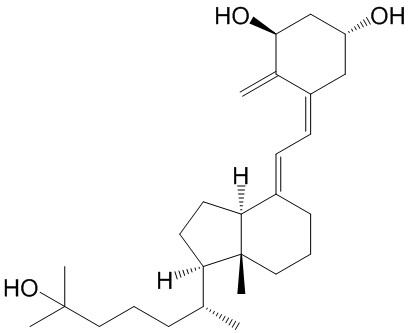Home
Products
Calcitriol



| Product Name | Calcitriol |
| Price: | $511 / 10mg |
| Catalog No.: | CN00243 |
| CAS No.: | 32222-06-3 |
| Molecular Formula: | C27H44O3 |
| Molecular Weight: | 416.64 g/mol |
| Purity: | >=98% |
| Type of Compound: | Alkaloids |
| Physical Desc.: | Powder |
| Source: | |
| Solvent: | Chloroform, Dichloromethane, Ethyl Acetate, DMSO, Acetone, etc. |
| SMILES: | O[C@H]1C[C@H](O)C(=C)/C(=CC=C2/CCC[C@]3(C2CC[C@@H]3[C@@H](CCCC(O)(C)C)C)C)/C1 |
| Contact us | |
|---|---|
| First Name: | |
| Last Name: | |
| E-mail: | |
| Question: | |
| Description | Calcitriol is the most active metabolite of vitamin D and also a vitamin D receptor (VDR) agonist. |
| Target | Human Endogenous Metabolite |
| In Vitro | Calcitriol exerts antiproliferative effects on cervical cancer cells in vitro. Cells decrease by 12.8% when treated with 100 nM Calcitriol for 6 days, compare with control. Inhibition of cell proliferation becomes more pronounced with the increase in Calcitriol concentration. The decrease is 26.1% and 31.6% for 200 and 500 nM Calcitriol, respectively. Treatment with Calcitriol for 72 h induces an evident accumulation of cells in the G1 phase, with approximately 66.18% in 200 nM and 78.10% in 500 nM, compare with the control (24.36%). Calcitriol treatment significantly decreases HCCR-1 protein expression compare with the control in a time- and dose-dependent manner[1]. Calcitriol significantly increases ERα mRNA in a dose dependent manner with an EC50 of 9.8×10-9 M[2]. |
| In Vivo | Chronic treatment with Calcitriol (150 ng/kg per day for 4.5 months) improves the relaxations (pD2: 6.30±0.09, Emax: 68.6±3.9% in Calcitriol-treated OVX, n=8). Renal blood flow in OVX rats is reduced in both kidneys, and the flow is restored by Calcitriol treatment. The increased expression of COX-2 and Thromboxane-prostanoid (TP) receptor in OVX rat renal arteries is reduced by chronic calcitriol administration[3]. High- and low-dose Calcitriol treatment significantly decreases the systolic blood pressure (SBP) in the fructose-fed rats by 14±4 and 9±4 mmHg, respectively, at Day 56. High-dose Calcitriol treatment (20 ng/kg per day) significantly increases serum ionized calcium level (1.44±0.05 mmol/L) compare with the other groups[4]. |
| Cell Assay | HeLa S3 cells are plated at a density of 1,000 cells/well in 96-well plates of Dulbecco’s modified Eagle’s medium (DMEM) with 10% fetal bovine serum (FBS), treated with 1% ethanol (control) or various concentrations of Calcitriol (100, 200, and 500 nM) for 72 h. A Cell Counting Kit8 (CCK-8) is used to determine cell proliferation. At 24, 48, 72, 96, 120, and 144 h after culturing with 200 nM Calcitriol, cells are harvested for analysis. Three independent experiments are performed in quadruplicate[1]. |
| Animal Admin | Adult female Sprague-Dawley rats weighing 200 to 220g are used in this study. Rats are housed in a temperature-controlled room (~23°C) with a 12-h light/dark cycle. The animals have free access to a standard diet and water. Ovariectomy (OVX) is performed on rats. At 6 months after the surgical procedure, the OVX rats are randomly assigned to either treatment with vehicle dimethyl sulfoxide (OVX+vehicle) or Calcitriol (150 ng/kg daily, OVX+calcitriol). Calcitriol treatment is given by oral gavage and lasted or 4.5 months. Blood pressure and serum Calcitriol level are measured[3]. |
| Density | 1.1±0.1 g/cm3 |
| Boiling Point | 565.0±50.0 °C at 760 mmHg |
| Flash Point | 238.4±24.7 °C |
| Exact Mass | 416.329041 |
| PSA | 60.69000 |
| LogP | 6.12 |
| Vapour Pressure | 0.0±3.5 mmHg at 25°C |